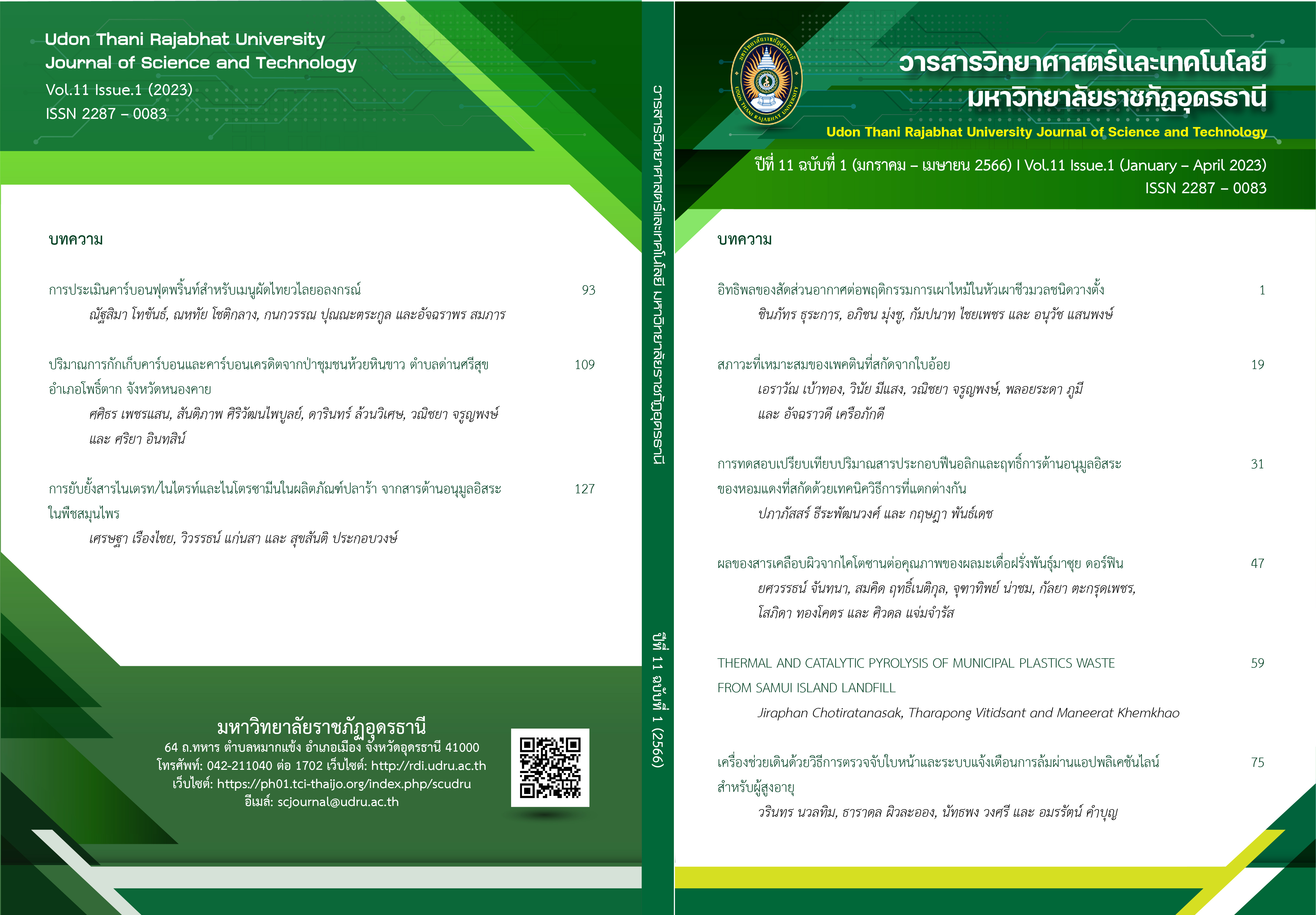THERMAL AND CATALYTIC PYROLYSIS OF MUNICIPAL PLASTICS WASTE FROM SAMUI ISLAND LANDFILL
Main Article Content
บทคัดย่อ
Plastic waste is the largest component of municipal solid waste (MSW) on Samui Island, which still has many management problems. Pyrolysis is an interesting technology that could help reduce plastic waste by converting it into more valuable fuels. Therefore, the focus of this research was to convert plastic waste from Samui Island into fuel via the thermal pyrolysis and catalytic pyrolysis processes. The pyrolysis reaction was carried out at various temperatures (390, 425, 450, and 475 ºC) with and without a catalyst in a 3-L bench-scale reactor to determine the optimal condition that produced the highest yield of pyrolysis oil. The raw material was a 1:1 weight ratio of high-density polyethylene (HDPE) and polypropylene (PP) plastic wastes, and the catalyst was 3 wt.% spent fluid catalytic cracking (FCC). The reaction time was determined until there was no liquid product left. The results revealed that 450 ºC was the optimal temperature for both the thermal pyrolysis and catalytic pyrolysis, with the highest pyrolysis oil yields of 84.21% and 70.12%, respectively. The pyrolysis oil components for the thermal pyrolysis were 37.00% naphtha, 18.60% kerosene, 37.40% diesel, and 7.00% long residue, while the catalytic pyrolysis were 39.90% naphtha, 17.10% kerosene, 35.40% diesel, and 7.60% long residue. Furthermore, thermal pyrolysis took longer than catalytic pyrolysis to complete.
Article Details
เอกสารอ้างอิง
Adnan, Shah, J., & Jan, M. R. (2014). Thermo-catalytic pyrolysis of polystyrene in the presence of zinc bulk catalysts. Journal of the Taiwan Institute of Chemical Engineers, 45(5), 2494–2500.
Aisien, E. T., Otuya, I. C., & Aisien, F. A. (2021). Thermal and catalytic pyrolysis of waste polypropylene plastic using spent FCC catalyst. Environmental Technology & Innovation, 22, 101455.
Baerlocher, Ch., & McCusker, L. B. (2016). Database of Zeolite Structures. Retrieved February 21, 2022 from http://www.iza-structure.org/databases/.
Chiranjeevi, T., Pragya, R., Gupta, S., Gokak, D. T., & Bhargava, S. (2016). Minimization of Waste Spent Catalyst in Refineries. Procedia Environmental Sciences, 35, 610–617.
Hakeem, I. G., Aberuagba, F., & Musa, U. (2018). Catalytic pyrolysis of waste polypropylene using Ahoko kaolin from Nigeria. Applied Petrochemical Research, 8(4), 203–210.
Kassargy, C., Awad, S., Burnens, G., Kahine, K., & Tazerout, M. (2018). Gasoline and diesel-like fuel production by continuous catalytic pyrolysis of waste polyethylene and polypropylene mixtures over USY zeolite. Fuel, 224, 764–773.
Lee, D., Nam, H., Wang, S., Kim, H., Kim, J. H., Won, Y., Hwang, B. W., Kim, Y. D., Nam, H., Lee, K. H., & Ryu, H. J. (2021). Characteristics of fractionated drop-in liquid fuel of plastic wastes from a commercial pyrolysis plant. Waste Management, 126, 411–422.
Maafa, I. (2021). Pyrolysis of Polystyrene Waste: A Review. Polymers, 13(2), 225.
Miandad, R., Barakat, M. A., Aburiazaiza, A. S., Rehan, M., Ismail, I. M. I., & Nizami, A. S. (2017a). Effect of plastic waste types on pyrolysis liquid oil. International Biodeterioration & Biodegradation, 119, 239–252.
Miandad, R., Barakat, M. A., Rehan, M., Aburiazaiza, A. S., Ismail, I. M. I., & Nizami, A. S. (2017b). Plastic waste to liquid oil through catalytic pyrolysis using natural and synthetic zeolite catalysts. Waste Management, 69, 66–78.
Panda, A. K. (2018). Thermo-catalytic degradation of different plastics to drop in liquid fuel using calcium bentonite catalyst. International Journal of Industrial Chemistry, 9(2), 167–176.
Saeaung, K., Phusunti, N., Phetwarotai, W., Assabumrungrat, S., & Cheirsilp, B. (2021). Catalytic pyrolysis of petroleum-based and biodegradable plastic waste to obtain high-value chemicals. Waste Management, 127, 101–111.
Singh, R. K., Ruj, B., Sadhukhan, A. K., & Gupta, P. (2019). Thermal degradation of waste plastics under non-sweeping atmosphere: Part 1: Effect of temperature, product optimization, and degradation mechanism. Journal of Environmental Management, 239, 395–406.
Singh, T. S., Verma, T. N., & Singh, H. N. (2020). A lab scale waste to energy conversion study for pyrolysis of plastic with and without catalyst: Engine emissions testing study. Fuel, 277, 118176.
Thai PBS. (2020). Recovering the municipal solid waste (MSW) of Samui Island from a capsized ferry accident during transportation. Retrieved February 20, 2022 from https://www.thaipbs.or.th/news/content/296474 (in Thai).
TISTR. (2020). The suitability study of the model and the approach for municipal solid waste disposal in Koh Samui Municipality [report]. (in Thai).
Zhang, Y., Ji, G., Chen, C., Wang, Y., Wang, W., & Li, A. (2020). Liquid oils produced from pyrolysis of plastic wastes with heat carrier in rotary kiln. Fuel Processing Technology, 206, 106455.


